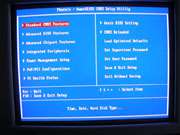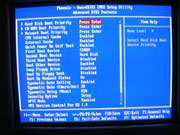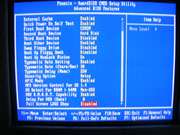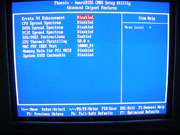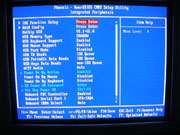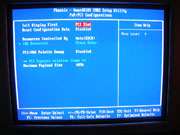- Qualcomm Launches Snapdragon 4 Gen 2 Mobile Platform
- AMD Launches Ryzen PRO 7000 Series Mobile & Desktop Platform
- Intel Launches Sleek Single-Slot Arc Pro A60 Workstation Graphics Card
- NVIDIA Announces Latest Ada Lovelace Additions: GeForce RTX 4060 Ti & RTX 4060
- Maxon Redshift With AMD Radeon GPU Rendering Support Now Available
DFI LanParty UT Ultra-D

DFI knows that hardcore gamers are interested in a motherboard with huge overclockability and modding potential. We are taking a look at the UT Ultra-D NF4, which promises just that.
Page 5 – BIOS
One of the reasons this board is so popular, is because of the feature packed BIOS. All these shots are from the 310 BIOS version. Sorry in advance for the bad quality snapshots.. it’s my cameras fault, not the photographers ;)
DFI chose the Pheonix Award BIOS for the Ultra-D, so most people will already be quite used to the navigation. The main screen view is much like all others, except for the addition of the CMOS Reloaded, which I will mention in a few paragraphs. When people say that this BIOS has a lot of options, it certainly is not an understatement. Firstly, in the Advanced Settings area, you are able to play with all the basics. Boot Priority and Boot Devices is one you will want to check out. If you have multiple OS’s (Operating Systems), you can choose which drive you want to boot from. This may be especially good if you do not have a proper boot chooser program installed.
It will even allow you to boot from a USB device if you choose to do so. A micro linux version may be fun to play around with. Or, if you do not have a floppy, you could boot something from it, like MemTest. I have yet to try this, but I see no problems in that working.
Under the Integrated Peripherals section, you can handle everything related to your peripherals, obviously. Here you can and should enable USB Keyboard Support, so that it will work in outside of an OS, IE: Choosing which OS to boot into. You can configure many other USB related options as well. You can even edit your RAID, if you have one.
Heading into the Genie BIOS Settings, will open up numerous tweaking options. Here, you can control your FSB, Multipliers, Dividers, Frequencys, Memory Timings and much more. Every setting that enthusiasts should have are here, and many that enthusiasts will never even touch. Voltages can be controlled as well. For the Memory voltages, it maxes out at 3.2V, but if you need more, there is a volt mod floating around.
|
|
Support our efforts! With ad revenue at an all-time low for written websites, we're relying more than ever on reader support to help us continue putting so much effort into this type of content. You can support us by becoming a Patron, or by using our Amazon shopping affiliate links listed through our articles. Thanks for your support!




